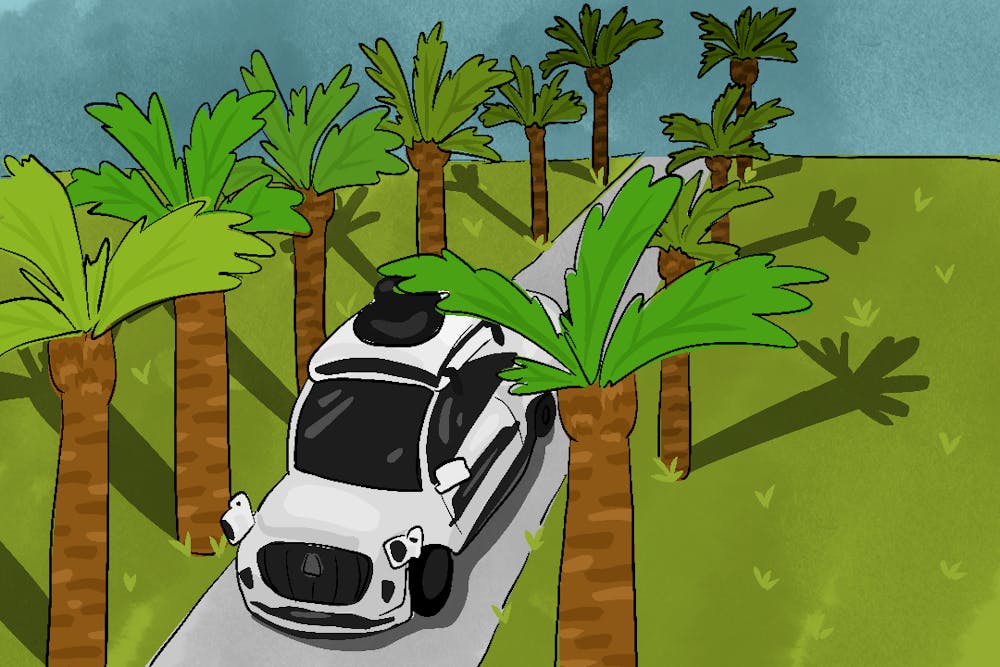Recently, a video was uploaded to TikTok by user @westcoastbakes that features a Waymo vehicle veering onto the wrong side of the road near the Dutch Bros on the intersection of Rural Rd. and Lemon St.
The video was recorded and uploaded by Emmie Wuest and recorded by Aiselyn Anaya-Hall, who both graduated from ASU in May 2024 with degrees in political science. Wuest explained that the Waymo was attempting to turn left when the light changed to red. Instead of stopping and not attempting to complete the turn, it continued into oncoming traffic.
Wuest directed Anaya-Hall to begin recording as the Waymo remained in the intersection through the green light. The pair faced a dilemma as they were surrounded by cars and blocked in as the autonomous vehicle tried to correct its course by driving directly toward the two.
"I tried (Waymo), and it was fine," Wuest said. "I was like, 'Oh, maybe I was wrong', and then this happened. I was like, delete [the app], never again."
The vehicle malfunctioned under rainy and high traffic conditions, which could have contributed to the error. According to an official Waymo blog post, the vehicles use radar and lidar to detect other road users in the event of low visibility conditions such as a haboob.
Waymo Vehicles, the autonomous driving service, was launched in 2022, using Downtown Phoenix as a test site. Since then, the company has expanded to Tempe, Scottsdale, Los Angeles, Austin and San Francisco. In January of 2023, Waymo cumulatively drove passengers 1 million miles.
In an announcement celebrating the landmark, they boasted about improving general road safety through a variety of metrics. They advertised only 18 minor contact events, no reported injuries, no events involving vulnerable road users and no intersection-related events since launching the program.
However, the video by Wuest and Anaya-Hall prompts the question: What does a rider do when an autonomous car appears to be on a collision course and you’re boxed in by peak Tempe traffic? In this case, traffic opened up enough to allow them to escape. Yet, the Waymo took about 15 seconds to maneuver out of oncoming traffic after the two left.
"It was like deer in the headlights to each other," Wuest said. "(The other passenger) was shocked, kind of horrified, but he couldn't do anything."
According to Wuest and Anaya-Hall, the other passenger seemed to be frantically on their phone. They believed the passenger was trying to contact Waymo about the situation.
This is not an isolated incident, either. Wuest stated this isn’t the first time she has witnessed Waymo vehicles making driving mistakes, but it was the most severe.
Meanwhile, ASU Police Department reported there was a minor accident in May by the Desert Financial Arena involving a Waymo vehicle. There have also been several other calls about stalled vehicles and blocked roads caused by the vehicles.
ASU associate professor in the School of Computing and Augmented Intelligence, Yu Zhang, researches human-robot interactions. According to him, most of the errors with autonomous vehicles occur in extreme driving situations.
"I think if you ask me that whether it's safe to ride a Waymo vehicle, I would say that ... on a regular day, probably." Zhang said. "But if you're talking about exceptional situations, like ... if we have a snowy day, probably, I wouldn't take a Waymo vehicle in that situation."
Rashmeet Kaur Nayyar is a Ph.D. student in computer science at ASU, where her work focuses on building efficient autonomous decision-making systems. According to her, improving autonomous cars relies on clear communication about extreme conditions to either avoid those situations entirely or to navigate them safely.
"There's no one model of how you learn, or what you learn, that is, but there are definitely general representations," Nayyar said. "Algorithms can use these representations ... (so) they don't have to do everything from scratch."
Considering the future of Waymo vehicle testing, Wuest expressed concerns about Waymo’s upcoming plans to test vehicles on the Loop 101.
Despite the many safety concerns surrounding Waymo vehicles, a study published in December 2023 claims a vehicle crash rate of 0.41 incidents per million miles for Waymo vehicles, while the human rate is 2.80 IPMM for police-reported incidents.
Waymo drivers aren’t perfectly safe, but neither are human drivers. Still, Waymo vehicles may need improvements to catch up to human reactions in extreme driving conditions.
Edited by River Graziano, Sophia Ramirez and Natalia Jarrett.
Reach the reporter at hsferrel@asu.edu.
Like The State Press on Facebook and follow @statepress on X.
Hayden is a junior studying mechanical engineering. This is her first semester with The State Press. She has also worked at SESE, NASA Europa ICONS, Lockhead Martin Space Engineered Biology, SESE Undergraduate Council and as a community assistant at Palo Verde East.




